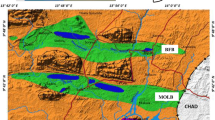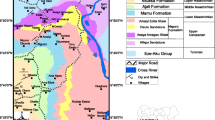Abstract
Attempt has been made to discuss the coupling relation of neotectonism and paleoclimate that have played a critical role in controlling the Quaternary sediment distribution and sedimentary facies evolution on the Yangtze coast. On the basis of petrological analysis, up to six sedimentary cyclicities have been identified in the Quaternary sediment boreholes on the time scale of 0.4–0.5 Ma. The lower sedimentary cyclicities (Pliocene to Early Pleistocene) are characterized largely by thicker gravelly coarse sands, topped by thinner fine silt and silty clay. Gravels are very angular and clayey gravels prevail. Sediments are usually of poor sorting, rich in log fragments and have no microfossils. Bedload as denoted by C-M plot occurs throughout the section. This evidence represents the alluvial fan sedimentation which took place as the basin began to subside. The middle sedimentary cyclicities (often including Early to Middle Pleistocene) consist of basal gravelly sands and clayey silt at the middle and upper sediment sections. Sorting becomes relatively better, and foraminifer appears sporadically. C-M plot reveals the mixture of sediment transport media via bedload, saltation and suspension, representing sedimentation of braided river system at the early stage and subsequently, the sedimentation of meandering river pattern. The upper sedimentary cyclicities (including Late Pleistocene to Holocene) comprise basal gravelly sands (exclusive of the Holocene sediment) and thick fine sand and silty clay on the upper section. Sorting becomes fine and foraminifer appears throughout the sediment section. C-M plot shows that saltation and suspension serve as the main sediment transport media in the sediment section and bedload transport weakens. These evidence the sedimentation of meandering river pattern near coast during Late Pleistocene and Holocene time, when marine transgression invaded into the paleoriver valleys, which often forms drowned-valley facies and shallow marine facies. Of note is the Recent delta facies developed on the top of the cyclicities, and characterized by a large proportion of fine sand and silty clay, and various sedimentary beddings. These phenomena have proved enhanced climate function on sedimentary fades evolution on the basis of previous alluvial fan system, largely affected by tectonic subsidence setting.
Similar content being viewed by others
References
Chen, Z., Holocene Nile Delta sea-level fluctuations and its impact on environmen—with special reference to the Changjiang river delta (in Chinese), Oceanic transaction, 2002, 24(2): 77–82. 1784
Zhao, S., Qing, Y., The marine transgression and sea-level fluctuation in 300ka at east China coast (in Chinese), Chinese Quaternary Research, 1985, 6(2): 97–103.
Zhu, S., Chen, Y., The Quaternary strata and climate in Shanghai region (in Chinese, eds. Yan, Q., Xu, S.), Shanghai: East China Normal University Press, 1987, 158–173.
Han, D., Yu, H., Relationship of activity of the Eastern Asia Monsoon in late stage of Upper Pleistocene and the sedimentary environment (in Chinese), Journal of Ocean University of Qingdao, 2001, 31(6): 911–916.
Chen, Z., Song, B., Wang, Z. et al., Late Quaternary evolution of the subaqueous Yangtze Delta: Stratigraphy, sedimentation, palynology and deformation, Marine Geology, 2000, 162: 423–441.
Chen, Z., Chen, Z., Wang, Z., Quaternary stratigraphy and trace-element indices of the Yangtze delta, Eastern China, with special reference to marine transgression, Quaternary Research, 1997, 47(2): 181–191.
Chen, Z., Stanley, D., Quaternary subsidence and river channel migration in the Yangtze Delta plain, Eastern China, Journal of Coastal Research, 1995, 11(3): 927–945.
Zhao, S., Zhang, H., Huang, Q. et al., Paleogeography of Yangtze Delta from Pliocene (in Chinese), Marine geography and Quaternary geography, 1982, 3(4): 35–44.
Bao, M., Song, Y., Liu, J. et al., The relationship of Quaternary hydro-geology, engineering geology, and the land subsidence characteristic in Shanghai (in Chinese), Shanghai Geography, 1981, 1: 42–46.
Huang, J., Wu, H., Sedimentary mechanism of the Pleistocene confined aquifers in Shanghai area (in Chinese), Shanghai Geography, 1992, 2: 15–23.
Lowe, J., Walker, M., Reconstructing Quaternary environments, London and New York: Longman Group Limited, 1984, 1–446.
Chen, Z., Yang, W., Quaternary Paleogeography and Paleoenvironment of Changjiang River estuarine region (in Chinese), ACTA Geographic Sinica, 1991, 46(4): 436–447.
Walker, R., James, N., Facies Models response to sea level change, Ontario: Love Printing Service Ltd., 1992, 1–409.
Visher, G., Stratigraphic systems, origin and application, London: Academic Press, 1999, 1–704.
Zhang, J., Zhang, G., Characteristics of the late Quaternary stratigraphic sequence in the Changjiang river delta area, Journal of Tongji University, 1998, 26(4): 438–442.
Li, C., Wang, P., The research of late Quaternary strata in Yangtze Estuary (in Chinese), Beijing: Scicence Press, 1998, 1–222.
Reading, H., Sedimentary environments and facies, London: Blackwell Scientific Publications, 1978, 1–557.
Wang, E., An important form of basin mountain coupling: Orogenic belt and flank basin, Chinese Science Bulletin, 2004, 49(6): 632–636.
Sun, Y., Li, H., Sediment faces and sedimentary environment, Beijing: Geography Press, 1986, 1–280.
Zheng, H., Butcher, K., Powell, C., Evolution of Neogene foreland basin in Yecheng, Xinjiang, and uplift of Northern Tibetan Plateau, ACTA Sedimentologica Sinica, 2002, 20(2): 274–281.
Author information
Authors and Affiliations
Corresponding author
About this article
Cite this article
Wang, Z., Chen, Z., Wei, Z. et al. Coupling controls of neotectonism and paleoclimate on the Quaternary sediments of the Yangtze (Changjiang) coast. Chin.Sci.Bull. 50, 1775–1784 (2005). https://doi.org/10.1360/04wd0089
Received:
Accepted:
Issue Date:
DOI: https://doi.org/10.1360/04wd0089




